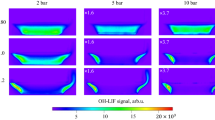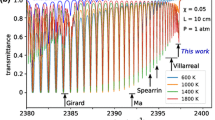Abstract
Quantitative measurements of radical concentrations are important in studies of the structure of flames. In this research, a quantitative analysis was performed using laser-induced predissociative fluorescence of OH radicals (OH-LIPF) in high-pressure (1–5 atm) premixed methane-air and propane-air flat flames (ϕ = 0.7–1.3). OH was excited (A 2Σ+, ν′ = 3 − X 2Π, ν″=0, and P28) using a KrF excimer laser and (3,2) band fluorescence was observed. OH fluorescence intensities were calibrated against the OH concentrations calculated from flame simulation results in the postflame zone using the CHEMKIN premix flame code in conjunction with the GRI-Mech 3.0 reaction mechanism. The accuracy and spatial resolution of temperature measurements are important factors for the correctness of the corresponding flame simulations, especially in the reaction zone near the burner surface. In this work, a carefully constructed thermocouple (R-type, 50 µm) positioning system was used to identify the temperatures above the burner surface. With careful evaluations of quenching rates, Voigt profiles, and normalization against room-air N2 Raman scattering intensity, a universal calibration constant [C T = (1.076 ± 0.174) · 1016 molecules/cm3] was determined. The OH concentrations obtained by flame simulations showed good agreement with the quantitative OH-LIPF measurements in all methane-air flames and fuel lean (ϕ = 0.7−0.8) propane-air flames. However, a 2-fold to 5-fold discrepancy was obtained in propane flames at ϕ > 0.9. This may be caused by the lack of C3 reaction paths in the GRI mechanism and/or the inaccuracy of the thermochemical data for large molecules.
Similar content being viewed by others
References
D. R. Crosley, “Semiquantitative laser-induced fluorescence in flames,” Combust. Flame, 78, 153–167 (1989).
J. W. Fleming, K. A. Burton, and H. D. Ladouceur, “OH and CH profiles in a 10 Torr methane/oxygen flame: Experiment and flame modeling,” Chem. Phys. Lett., 175, No. 4, 395–400 (1990).
D. E. Heard, J. B. Jeffries, G. P. Smith, and D. R. Crosley, “LIF measurements in methane-air flames of radicals important in prompt-NO formation,” Combust. Flame, 88, No. 2, 137–148 (1992).
J. S. Bernstein, A. Fein, J. B. Choi, T. A. Cool, R. C. Sousa, S. L. Howard, R. J. Locke, and A. W. Miziolek, “Laser-based flame species profile measurements; A comparison with flame model predictions,” Combust. Flame, 92, Nos. 1–2, 85–105 (1993).
P. A. Berg, D. A. Hill, A. R. Noble, G. P. Smith, J. B. Jeffries, and D. R. Crosley, “Absolute CH concentration measurements in low-pressure methane flames: comparisons with model results,” Combust. Flame, 121, Nos. 1–2, 223–234 (2000).
P. Andresen, A. Bath, W. Groger, H. W. Lulf, G. Meijer, and J. J. Meulen, “Laser-induced fluorescence with tunable excimer lasers as a possible method for instantaneous temperature field measurements at high pressures: checks with an atmospheric flame,” Appl. Opt., 27, No. 2, 365–378 (1998).
P. Andresen, G. Meijer, H. Schluter, H. Voges, A. Koch, W. Hentshel, W. Oppermann, and E. Rothe, “Fluorescence imaging inside an internal combustion engine using tunable excimer lasers,” Appl. Opt., 29, No. 16, 2392–2404 (1990).
J. H. Bechtel and R. E. Teets, “Hydroxyl and its concentration profile in methane-air flames,” Appl. Opt., 18, No. 24, 4138–4144 (1979).
J. H. Grinstead, G. Laufer, R. H. Krauss, and J. C. Mc-Daniel (Jr)., “Calibration source for OH laser-induced fluorescence-density measurements with thermally dissociated H2O in atmospheric air,” Appl. Opt., 33, No. 6, 1115–1119 (1994).
T. S. Cheng, J. A. Wehrmeyer, and R. W. Pitz, “Simultaneous temperature and multispecies measurement in a lifted hydrogen diffusion flame,” Combust. Flame, 91, No. 3–4, 323–345 (1992).
Q. V. Nguyen and P. H. Paul, “KrF laser-induced photo-bleaching effects in O2 planar laser-induced fluorescence signals: Experiment and model,” Appl. Opt., 36, 2675–2683 (1997).
R. J. Kee, J. F. Grcar, M. D. Smooke, and J. A. Miller, “PREMIX: A Fortran program for modeling laminar one-dimensional premixed flames,” Sandia National Laboratories Report No. SAND85-8240 (1985). http://www.ca.sandia.gov/chemkin/.
M. C. Drake and R. J. Blint, “Calculations of NOx formation pathways in propagating laminar, high pressure premixed CH4/air flames,” Combust. Sci. Technol., 75, No. 4, 261–285 (1991).
P. Glarborg, M. U. Alzueta, D. J. Kim, and J. A. Miller, “Kinetic modeling of hydrocarbon/nitric oxide interactions in a flow Reactor,” Combust. Flame, 115, Nos. 1–2, 1–27 (1998).
G. P. Smith, D. M. Golden, M. Frenklach, et al., GRIMech 3.0 (1999). http://www.me.berkeley.edu/gri_mech/version30/text30.html.
A. C. Eckbreth, “Laser diagnostics for combustion temperature and species,” in: Combustion Science and Technology Book Series, Vol. 3, Gordon and Breach (1996).
JANAF Thermochemical Tables, National Standards Reference Data Series, Report No. NSRDS-NBS 37.
R. P. Lucht, R. C. Peterson, and N. M. Laurendeau, “Fundamentals of absorption spectroscopy for selected diatomic flame radicals,” Report No. PURDU-CL-78-06 (1978).
J. Luque and D. R. Crosley, “LIFBASE: Database and spectral simulation program, SRI International,” http://www.sri.com/psd/lifbase/.
D. E. Heard, D. R. Crosley, J. B. Jeffries, G. P. Smith, and A. Hirano, “Rotational level dependence of predissociation in the ν′ = 3 Level of OH A 2Σ+,” J. Chem. Phys., 96, No. 6, 4366–4371 (1992).
M. Tamura, P. A. Berg, J. E. Harrington, J. Luque, J. B. Jeffries, G. P. Smith, and D. R. Crosley, “Collisional quenching of CH(A), OH(A), and NO(A) in low pressure hydrocarbon flames,” Combust. Flame, 114, Nos. 3–4, 502–514 (1998).
N. L. Garland and D. R. Crosley, “On the collisional quenching of electronically excited OH, NH and CH in flames,” in: 21th Symp. (Int.) on Combustion, 1693–1702 (1986).
F. A. Williams, “Chemical-kinetic mechanisms for combustion applications,” http://www-mae.ucsd.edu/~combustion/cermech/.
D. L. Baulch, A. M. Cox, T. Just, J. A. Kerr, M. Pilling, J. Troe, R. W. Walker, and J. Warnatz, “Compilation of rate data on C1/C2 species oxidation,” J. Phys. Chem. Ref. Data, 21 (1991).
Author information
Authors and Affiliations
Corresponding author
Additional information
__________
Translated from Fizika Goreniya i Vzryva, Vol. 45, No. 4, pp. 67–76, July–August, 2009.
Rights and permissions
About this article
Cite this article
Yuan, T.H., Lai, Y.H., Lu, C.J. et al. Universal calibration of quantitative OH-LIPF measurements in hydrocarbon flames at elevated pressures. Combust Explos Shock Waves 45, 404–412 (2009). https://doi.org/10.1007/s10573-009-0050-4
Received:
Published:
Issue Date:
DOI: https://doi.org/10.1007/s10573-009-0050-4




